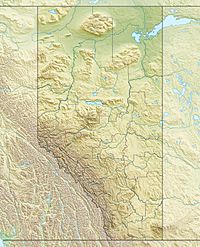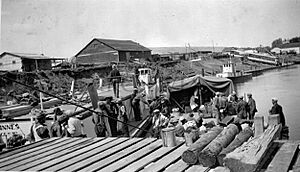Waterways, Alberta facts for kids
Waterways is a small area, or locality, located in northern Alberta, Canada. It's part of the Regional Municipality of Wood Buffalo. Today, Waterways is a neighbourhood within the larger town of Fort McMurray. It sits on the west side of the Clearwater River, just south of where the Clearwater River joins the Athabasca River.
Contents
A Look at Waterways' Past
How Waterways Became a Shipping Hub
In 1921, Waterways became a very important place for shipping goods. This happened when the Alberta and Great Waterways Railway line reached the town. This made Waterways the farthest north you could go by train in North America!
Goods heading even farther north were brought to Waterways by train. Then, they were moved onto large boats called barges. Fleets of tugboats would then pull these barges to places along the Mackenzie River and its connected waterways.
Oil Sands Development and Waterways
In 1930, a scientist named Karl Clark sent a special machine to Waterways. This machine was designed to separate a thick, sticky oil called bitumen from the Athabasca oil sands. He set up his plant nearby, across the Clearwater River.
Since then, the railway line to Waterways has been super important. It helps transport heavy equipment and supplies. These items are needed to develop the oil sands and help the nearby communities grow.
Waterways and Salt Production
In 1937, a salt plant was built in Waterways. This plant was designed to get rock salt from deep underground. They used a method called solution mining, which involves dissolving the salt and then evaporating the water.
The salt came from a layer of rock called the Prairie Evaporite Formation. This layer was about 60 meters (200 feet) thick and located about 210 meters (700 feet) deep. The plant worked until 1950 and produced a lot of salt – about 207,000 metric tons (228,000 short tons)!
Waterways' Role in World War II
During the Second World War, Waterways was a secret and important place. It was a transfer point for a special ore called pitchblende. This ore was mined at the Eldorado Mine far to the north.
The pitchblende was shipped by barges to Waterways. Once it arrived, it was moved onto train cars. From there, it was sent to Port Hope, Ontario. This whole operation was top-secret because the pitchblende was a source of uranium for the Manhattan Project. This project was a secret effort to build the first atomic bombs.
Later, some areas around Waterways had to be cleaned up because of leftover nuclear materials.
Changes in Shipping and Rail Lines
By 1964, the long-distance shipping from Waterways to the Mackenzie River area stopped. This happened because Hay River, a town on Great Slave Lake in the Northwest Territories, became the new northern end of the railway system.
However, local shipping from Waterways continued. The railway line that went to Waterways became part of different railway companies over the years. These included the Northern Alberta Railway, the Canadian National Railway, the Athabasca Northern Railway, and eventually back to the Canadian National Railway.
The 2016 Wildfire and Waterways
In 2016, a very large wildfire, known as the 2016 Fort McMurray Wildfire, caused a lot of damage. Waterways was hit very hard by this fire. Reports from May 4 showed that 90% of the homes in Waterways were destroyed by the wildfire.
Population of Waterways
In 2006, the Waterways neighbourhood had a population of 750 people, according to the local census.
See also
In Spanish: Waterways para niños



